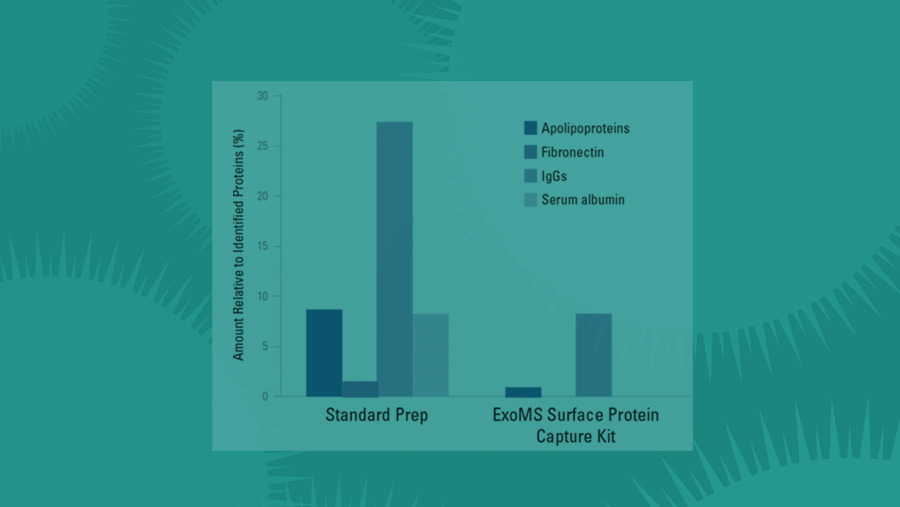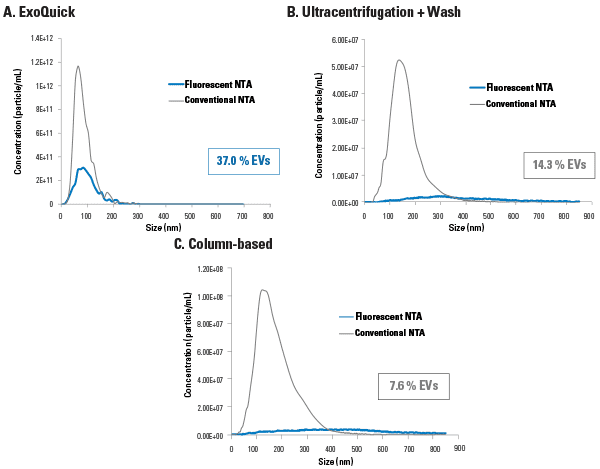Meet the newest exosome research products
Welcome, again, to SBI’s new blog! One of the things we’re going to do with this section of the website is to let readers know what new products have just been released. In this post, we’d like to draw your attention to four new exosome research products that launched in July, and that are designed to improve the accuracy of your exosome studies.
ExoGlow-NTA for more accurate NanoSight™ analysis of extracellular vesicles (EVs)
Many exosome researchers use nanoparticle tracking analysis (NTA) to measure exosome particle size distribution as a way of verifying that the sample prep contains particles of the right size to be exosomes, and to measure the concentration of exosome particles. However, because NTA is based on light scattering, it can’t discriminate between EVs and similarly-sized contaminants, such as protein aggregates. The result is an overestimation of the exosome concentration.
To overcome this challenge, SBI has developed the new ExoGlow-NTA reagent for fluorescent NTA. ExoGlow-NTA binds to intact EV membranes, but not membrane fragments or protein aggregates. Thus it can be used as an EV-specific label for fluorescent NTA, delivering a more accurate NanoSight-based measurement of EV particle size distribution and concentration. Figure 1 shows how much EV concentration can be overestimated when using conventional NTA.
Figure 3. ExoGlow-NTA demonstrates that conventional NTA overestimates EV concentration in samples irrespective of EV isolation method. Representative data comparing conventional NTA and fluorescent NTA for EVs isolated using (A) ExoQuick (10 µg serum protein), (B) ultracentrifugation and wash (1 µg serum protein), or (C) column-based isolation (1 µg serum protein), shows just how much of the conventional NTA signal is due to non-EV particles.Learn more about our ExoGlow-NTA product here, and about our Fluorescent NTA service here.
A trio of ExoMS Protein Capture Kits
For researchers interested in exosome proteomics, we’ve improved our exosome protein preparation kits to increase your ability to isolate EV proteins. As we’ve shown with the ExoGlow-NTA reagent, current exosome isolation protocols can greatly overestimate the EV concentration, which can lead to preps greatly enriched in protein contaminants such as albumin or IgG. When doing mass spec with these samples, the albumin and IgG signals can swamp out the signals from the EV proteins that you’re actually interested in studying. Thus, our all new ExoMS Protein Capture Kits.
The ExoMS Protein Capture Kits come in three versions suitable for different applications:
- ExoMS Surface Protein Capture Kit (Serum/Plasma) for exosomes isolated from serum or plasma
- ExoMS Surface Protein Capture Kit (Tissue Culture) for exosomes isolated from tissue culture or biofluids other than serum or plasma
- ExoMS Total Protein Capture Kit for exosomes isolated from any fluid
You first isolate exosomes using your preferred protocol, and then prepare proteins for mass spec using one of these kits. Because the kits are selective for either EV surface proteins (the two ExoMS Surface Protein Capture Kits) or total EV protein (the ExoMS Total Protein Capture Kit), you end up with better, more relevant proteomics data. And the workflow is quick and easy!
Learn more about our ExoMS Surface Protein Capture Kit (Serum/Plasma) here, the ExoMS Surface Protein Capture Kit (Tissue Culture) here, and the ExoMS Total Protein Capture Kit here.
We can also take care of all or some of the exosome isolation, protein prep, mass spec, AND data analysis and interpretation steps for you with our Exosome Proteomics Service—learn more here.



